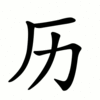历
Appearance
| ||||||||
Translingual
[edit]| Stroke order | |||
|---|---|---|---|
| Stroke order | |||
|---|---|---|---|

| |||
| Traditional | 歷 |
|---|---|
| Shinjitai | 歴 |
| Simplified | 历 |
| Traditional | 曆 |
|---|---|
| Shinjitai | 暦 |
| Simplified | 历 |
Han character
[edit]历 (Kangxi radical 27, 厂+2, 4 strokes, cangjie input 一大尸 (MKS) or 難一大尸 (XMKS), four-corner 7122, composition ⿸厂力)
Derived characters
[edit]References
[edit]- Kangxi Dictionary: not present, would follow page 160, character 18
- Hanyu Da Zidian (first edition): volume 1, page 68, character 4
- Unihan data for U+5386
Chinese
[edit]Glyph origin
[edit]Simplified from 歷 and 曆 by keeping the character's basic structure but replacing the components under 厂 with phonetic 力 (lì).
Etymology 1
[edit]| For pronunciation and definitions of 历 – see 歷 (“to experience; to go through; to undergo; experience; history; record; etc.”). (This character is the simplified form of 歷). |
Notes:
|
Etymology 2
[edit]| For pronunciation and definitions of 历 – see 曆 (“calendar”). (This character is the simplified form of 曆). |
Notes:
|
Categories:
- CJK Unified Ideographs block
- Han script characters
- CJKV characters simplified differently in Japan and China
- Translingual lemmas
- Translingual symbols
- CJKV simplified characters
- Chinese lemmas
- Mandarin lemmas
- Cantonese lemmas
- Taishanese lemmas
- Hakka lemmas
- Northern Min lemmas
- Eastern Min lemmas
- Hokkien lemmas
- Teochew lemmas
- Wu lemmas
- Middle Chinese lemmas
- Old Chinese lemmas
- Chinese hanzi
- Mandarin hanzi
- Cantonese hanzi
- Taishanese hanzi
- Hakka hanzi
- Northern Min hanzi
- Eastern Min hanzi
- Hokkien hanzi
- Teochew hanzi
- Wu hanzi
- Middle Chinese hanzi
- Old Chinese hanzi
- Chinese verbs
- Mandarin verbs
- Cantonese verbs
- Taishanese verbs
- Hakka verbs
- Northern Min verbs
- Eastern Min verbs
- Hokkien verbs
- Teochew verbs
- Wu verbs
- Middle Chinese verbs
- Old Chinese verbs
- Chinese nouns
- Mandarin nouns
- Cantonese nouns
- Taishanese nouns
- Hakka nouns
- Northern Min nouns
- Eastern Min nouns
- Hokkien nouns
- Teochew nouns
- Wu nouns
- Middle Chinese nouns
- Old Chinese nouns
- Chinese adjectives
- Mandarin adjectives
- Cantonese adjectives
- Taishanese adjectives
- Hakka adjectives
- Northern Min adjectives
- Eastern Min adjectives
- Hokkien adjectives
- Teochew adjectives
- Wu adjectives
- Middle Chinese adjectives
- Old Chinese adjectives
- Chinese adverbs
- Mandarin adverbs
- Cantonese adverbs
- Taishanese adverbs
- Hakka adverbs
- Northern Min adverbs
- Eastern Min adverbs
- Hokkien adverbs
- Teochew adverbs
- Wu adverbs
- Middle Chinese adverbs
- Old Chinese adverbs
- Chinese proper nouns
- Mandarin proper nouns
- Cantonese proper nouns
- Taishanese proper nouns
- Hakka proper nouns
- Northern Min proper nouns
- Eastern Min proper nouns
- Hokkien proper nouns
- Teochew proper nouns
- Wu proper nouns
- Middle Chinese proper nouns
- Old Chinese proper nouns
- Chinese terms spelled with 历
- Chinese simplified forms
- Sichuanese lemmas
- Gan lemmas
- Jin lemmas
- Leizhou Min lemmas
- Puxian Min lemmas
- Xiang lemmas
- Sichuanese hanzi
- Gan hanzi
- Jin hanzi
- Leizhou Min hanzi
- Puxian Min hanzi
- Xiang hanzi
- Sichuanese nouns
- Gan nouns
- Jin nouns
- Leizhou Min nouns
- Puxian Min nouns
- Xiang nouns

